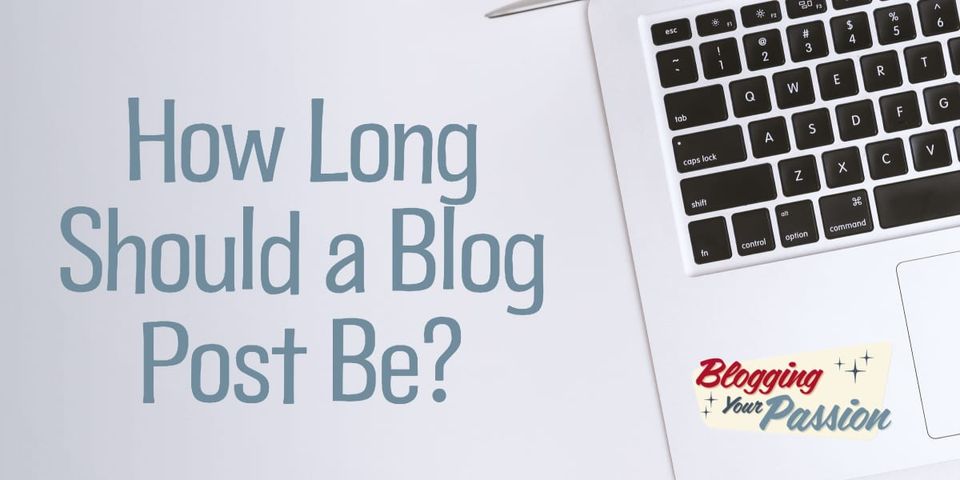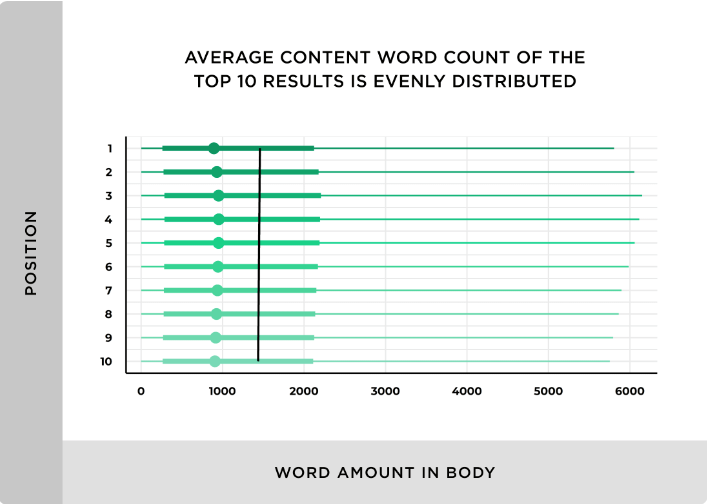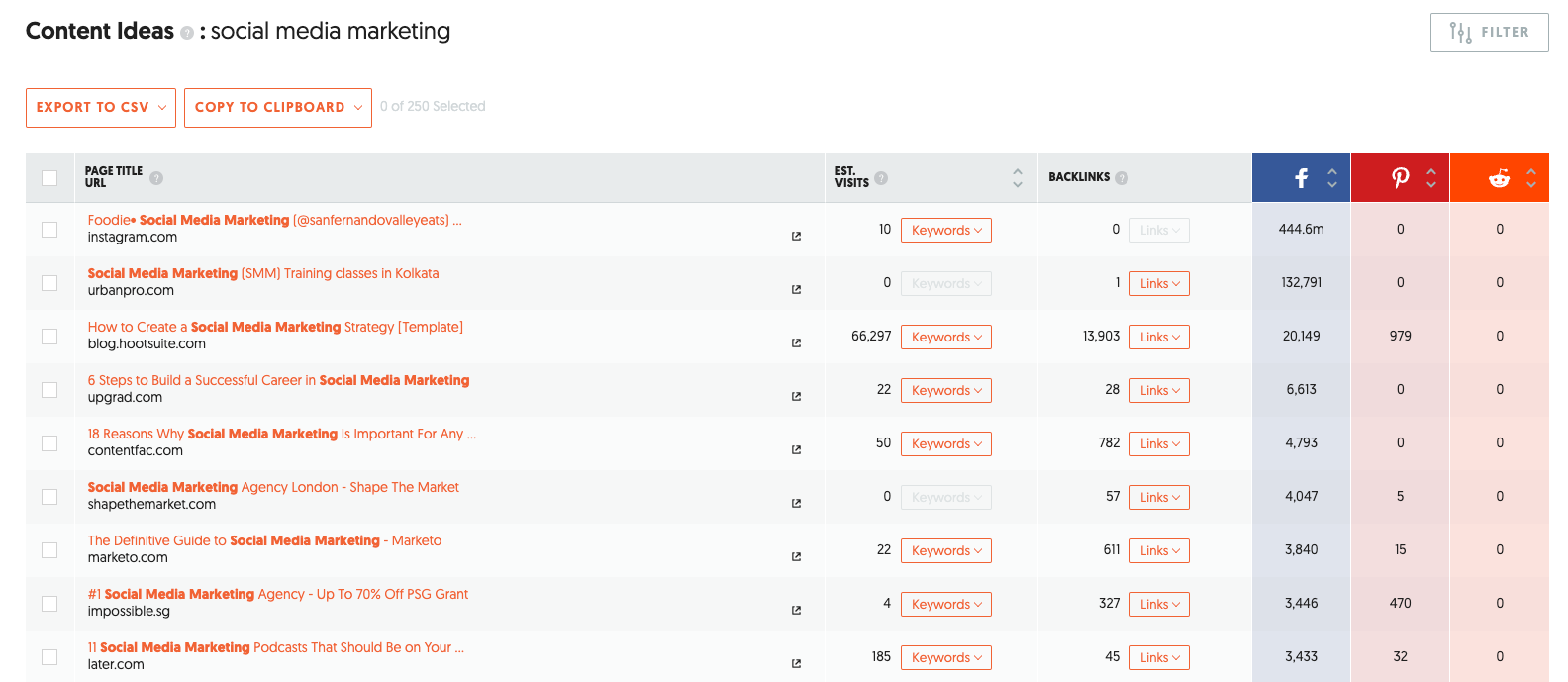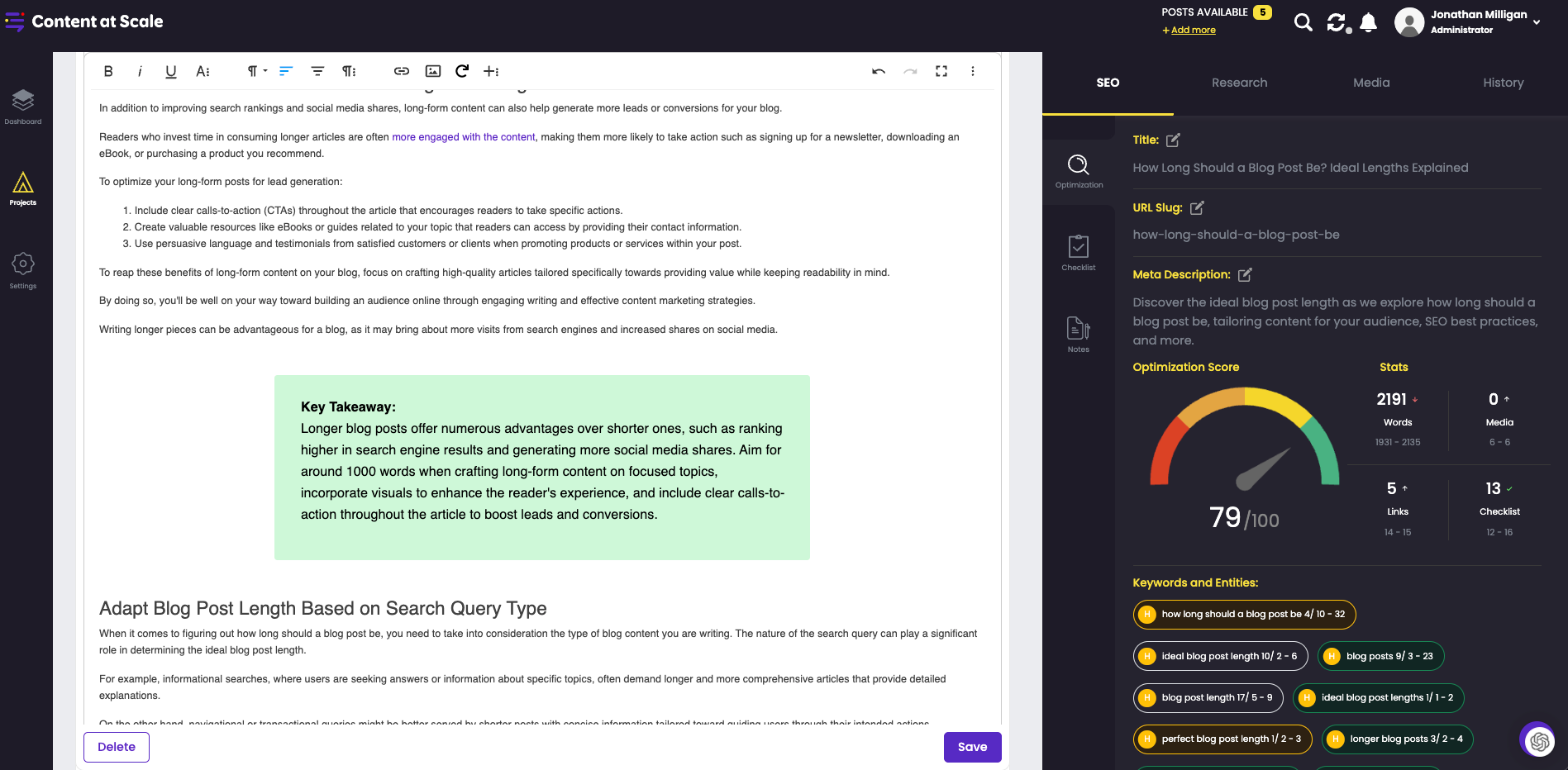How Long Should a Blog Post Be? The Optimal Length for SEO

No single answer exists when it comes to the question of how long a blog post should be.
The ideal length of your content depends on various factors such as audience preferences, topic complexity, and SEO goals.
In this blog post, we will explore the different aspects of blog post length and help you find the perfect balance for your written content. We'll dive into what constitutes an ideal blog post length for your blog.
Of course, we are assuming in this article that you have already started a blog.
We'll also examine how to optimize your content for search engines while ensuring readability and engagement for your readers. In addition to that, you'll learn about strategies for optimizing your content's length by incorporating effective formatting techniques like headers and visuals.
We will also delve into the benefits of writing longer-form content when it comes to visibility in search engines and generating discussion among readers Lastly, our expert tips will guide you through crafting compelling long-form articles without sacrificing quality or reader interest.
So buckle up as we embark on this journey toward finding the perfect blog post length!
Table of Contents (click to expand)
- Ideal Blog Post Length
- Content Goals and Their Impact on Blog Post Length
- Target Audience Preferences Influencing Ideal Lengths
- Long-Form Content Benefits
- Rank Higher in Search Engine Results with Longer Articles
- Generate More Social Media Shares by Engaging Long-Form Content
- Boost Leads and Conversions with Long-Form Blog Posts
- Adapt Blog Post Length Based on Search Query Type
- Balance Quality and Comprehensiveness in Blog Posts
- Prioritize Quality over Word Count
- Ensure Comprehensiveness within Your Content
- FAQs on How Long Should a Blog Post Be
- Is 500 words too short for a blog post?
- Is 5,000 words too long for a blog post?
- How long should a 1,000-word blog post take?
- Are 700 words enough for a blog post?
- Conclusion
Ideal Blog Post Length
The ideal blog post length depends on various factors such as content goals, target audience, search intent, and SEO best practices. According to HubSpot, long-form content with around 1000 words is generally considered the perfect length for a blog post.
It's essential to focus on delivering beneficial, tailored material for your target audience instead of just worrying about the number of words.
Content Goals and Their Impact on Blog Post Length
Your blog's purpose will significantly influence the optimal length of your posts. For instance, if you aim to provide in-depth information or detailed tutorials, longer articles may be necessary.
On the other hand, shorter posts might suffice for quick updates or news items.
- In-depth Information: Long-form content works well when you need to explain complex concepts or provide comprehensive guides that require more space and detail.
- Quick Updates: Shorter posts are suitable for sharing timely news or brief announcements that don't require extensive elaboration.
Target Audience Preferences Influencing Ideal Lengths
Different audiences have varying preferences when it comes to reading online material. Some readers prefer concise articles that get straight to the point while others enjoy immersive long reads packed with information and insights.
To determine what works best for your specific audience:
- Analyze reader engagement metrics like time spent on the page and bounce rate using tools like Google Analytics;
- Gather feedback from readers through comments sections or social media interactions;
These can provide valuable insights into how your audience engages with your content, helping you fine-tune the ideal blog post length for maximum impact.
To summarize, the ideal blog post length should be determined by content goals and target audience preferences.
That being said, long-form content offers a variety of benefits that can help bloggers increase their reach and engagement with readers.
Long-Form Content Benefits
Longer blog posts offer numerous advantages over their shorter counterparts, performing better in almost every metric. Long-form content offers a range of benefits, and this section will discuss how to use it for improved blog performance.
Rank Higher in Search Engine Results with Longer Articles
Longer articles are more likely to be favored by search engines and appear higher in SERPs due to their ability to provide detailed information of value. This is because search engines like Google prioritize high-quality, informative content that provides value to readers.
According to a recent ranking factors industry study, the average length of a first-page Google result is approximately 1400 words.

This suggests that longer content may have an advantage in terms of SEO and ranking on search engines. However, as previously mentioned, the length of your blog post should ultimately be determined by your audience, content type, and goals.
By writing longer articles that delve deeper into a topic, you are signaling to search engines that your content is worth ranking higher than less-detailed pieces.
Generate More Social Media Shares by Engaging Long-Form Content
Social media shares play an essential role in increasing your blog's visibility and attracting new readers.
Research has demonstrated that extended articles are more likely to be shared on social media, as they give users more material with which to interact and spread around their networks.
For example, the UberSuggest Keyword Tool has a feature that allows you to see the topic headlines with the most social media shares.

To maximize social sharing potential, ensure your long-form content includes compelling headlines, interesting facts or statistics, and quotes from experts or influencers related to the topic at hand.
- Ideal Blog Post Length: Aim for around 1400 words when crafting long-form content.
- Focused Topics: Choose specific topics relevant to your audience's interests rather than trying to cover too many subjects within one post.
- Incorporate Visuals: Add images or infographics where appropriate to break up text and enhance the reader's experience.
Boost Leads and Conversions with Long-Form Blog Posts
In addition to improving search rankings and social media shares, long-form content can also help generate more leads or conversions for your blog.
Readers who invest time in consuming longer articles are often more engaged with the content, making them more likely to take action such as signing up for a newsletter, downloading an eBook, or purchasing a product you recommend.
To optimize your long-form posts for lead generation:
- Include clear calls-to-action (CTAs) throughout the article that encourages readers to take specific actions.
- Create valuable resources like eBooks or guides related to your topic that readers can access by providing their contact information.
- Use persuasive language and testimonials from satisfied customers or clients when promoting products or services within your post.
To reap these benefits of long-form content on your blog, focus on crafting high-quality articles tailored specifically towards providing value while keeping readability in mind.
By doing so, you'll be well on your way toward building an audience online through engaging writing and effective content marketing strategies.
Writing longer pieces can be advantageous for a blog, as it may bring about more visits from search engines and increased shares on social media.
Adapt Blog Post Length Based on Search Query Type
When it comes to figuring out how long should a blog post be, you need to take into consideration the type of blog content you are writing. The nature of the search query can play a significant role in determining the ideal blog post length.
For example, informational searches, where users are seeking answers or information about specific topics, often demand longer and more comprehensive articles that provide detailed explanations.
On the other hand, navigational or transactional queries might be better served by shorter posts with concise information tailored toward guiding users through their intended actions.
- Informational Queries: Aim for longer articles (1k - 2.5k words) that thoroughly cover various aspects of a topic.
- Navigational Queries: Shorter blog posts (500 - 1k words) with clear guidance and relevant links work best.
- Transactional Queries: Concise content (300 - 700 words) focusing on product/service features and benefits is ideal. Unless you are trying to rack for a product review. In that case, 1,400+ gives you a better chance of ranking at the top of the search engines.
As you can see, ideal blog post lengths can vary depending on the type of blog post you are writing. However, the average blog post seems to be around 1,000-1,400 words. This can take a long time to write unless you use a tool like Contentatscale.
ai.

But sometimes you have to just start writing and see how long the article length is based on the topic you've chosen. To improve your chances of ranking on search engines, it's often recommended to write longer blog posts.
Balance Quality and Comprehensiveness in Blog Posts
Ultimately, success in writing comes down mostly to the quality and comprehensiveness of each individual article published online. Therefore, always strive to achieve both of these aspects whenever possible, regardless of the specific lengths that might be chosen overall.
Focus on providing valuable information that caters specifically to your target audience's needs while keeping an eye out for readability, engagement, and optimization factors.
Prioritize Quality over Word Count
While it is essential to consider the ideal blog post length, do not let the word count dictate the value of your content.
Instead, prioritize creating high-quality content that resonates with your readers by addressing their pain points or answering their questions effectively.
Ensure that you:
- Maintain a clear focus on your topic throughout the post.
- Use credible sources when citing facts or statistics.
- Edit and proofread thoroughly before publishing.
Ensure Comprehensiveness within Your Content
Make sure to include all relevant aspects of the subject matter in your blog content, so you can be seen as an authoritative figure and increase reader satisfaction.
This will help establish you as an authority figure within your niche while also increasing reader satisfaction levels too.
To ensure comprehensiveness:
- Research extensively: Gather sufficient information from multiple reputable sources like industry reports or expert opinions so as not only to provide accurate data but also to offer unique insights/angles upon existing topics discussed elsewhere already.
- Structure your content: Organize your blog article into logical sections using headings and subheadings, making it easier for readers to navigate through the information provided.
- Include examples and case studies: Incorporate real-life examples or case studies that support your points, helping readers understand complex concepts more easily while also adding credibility overall too.
Remember that balancing quality and comprehensiveness within each article published online is key to achieving success as a blogger.
To build an engaged audience, provide valuable information that meets reader preferences while maintaining readability, engagement, and optimization.
FAQs on How Long Should a Blog Post Be
Is 500 words too short for a blog post?
While 500 words can be sufficient for some topics, it may not provide enough depth and value to readers. Aim for at least 1,000-2,000 words to improve SEO performance and user engagement.
However, always prioritize quality over quantity. Short posts do have a purpose when it comes to certain topics.
Is 5,000 words too long for a blog post?
A 5,000-word blog post is not necessarily too long if the content is valuable and well-structured. Long-form content can rank higher in search engines and generate more social media shares.
Ensure that your lengthy posts remain engaging and relevant throughout.
How long should a 1,000-word blog post take?
The time required to write a 1,000-word blog post varies depending on research needs and writing speed. On average, it could take anywhere from two to four hours or more.
Always allocate enough time for editing and proofreading before publishing.
Are 700 words enough for a blog post?
A well-written 700-word article can be effective; however, studies suggest aiming between 1k-2k+ words improves SEO ranking and reader engagement.
Consider tailoring length based on search query type and domain authority while maintaining the quality and comprehensiveness of content.
Conclusion
When it comes to crafting a blog post, every blogger inevitably ponders how long should a blog post be. After going through this article, we have learned that there is no one-size-fits-all answer to this question.
The ideal length for a blog post depends on various factors such as the audience and topic complexity, quality versus quantity, formatting, and readability.
However, longer posts tend to perform better in terms of SEO and engagement as they provide more comprehensive information and generate leads.
Overall, writers should focus on creating high-quality content that engages their readers, regardless of its length.
By utilizing the strategies outlined above, such as breaking up text with headers/subheaders or incorporating visuals into your posts, you can ensure that your readers will stay engaged throughout the entire post.
